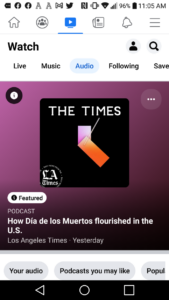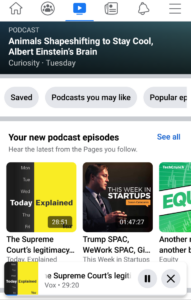Facebook launched podcast listening in its mobile apps during the summer. We tested it this week to learn its features and functions. We were interested in how the experience might contribute to raising awareness of podcasting in Facebook’s billions of users around the world — or even just the 221-million Americans on the platform — and how the experience compares to stand-alone podcatchers.
Podcast Discovery in Facebook

Podcasts are located in the Video portion of Facebook, in an Audio section, under Watch. The placement assures that few users will find them.
From the start, finding podcasts is not easy in Facebook. The attitude which seems to inform the UX is that podcasts are unimportant. The simple fact of podcast availability on the platform is not placed upfront in the main navigation of the web app or the (Android) mobile experience.
Facebook has stuffed podcasts (bizarrely) within the Video tab in both those environments. Even there, the word “podcasts” does not appear; users must click Audio to find podcasts. There, podcasts are under a navigational section called “Watch,” which is confusing. The user scrolls down to see banners for podcasts. They can be tapped to listen.
Theshows presented to the user are presumably meant to reflect that user’s Facebook connections and clicks. Results are not convincing. In our testing, a section called “Podcasts You Might Like” delivered a peculiar and inscrutable list. In the first 20 recommended shows, we recognized one title. Nothing wrong with that — in fact, we wish other podcast apps would break away from the Top 10 when introducing newcomers to podcasting. But the remaining 19 were flagrantly irrelevant, as with Buckeye Talk, an Ohio State podcast that could not be more bizarrely distant from the account’s topicality.
Listening
 Listening happens in two ways. First you can preview a podcast, or listen to the whole thing, without leaving the basic browse function. Doing so launches the audio, without controls. Alternately, tapping on the play ribbon at screen bottom opens a full-featured playback experience that includes show notes, closed captioning, a mute button, FF and rewind scrubbing, and 10-second forward and backward skipping.
Listening happens in two ways. First you can preview a podcast, or listen to the whole thing, without leaving the basic browse function. Doing so launches the audio, without controls. Alternately, tapping on the play ribbon at screen bottom opens a full-featured playback experience that includes show notes, closed captioning, a mute button, FF and rewind scrubbing, and 10-second forward and backward skipping.
We found an audio speed feature for sped-up or slowed-down listening. But it is perplexingly hidden within the Settings icon, contrary to most other podcast apps which put those controls on the main playback panel.
Closed Captioning (CC) is activated for some, not all, podcasts. (It is also secluded in the Settings cluster, along with the playback speeds.) CC is disappointingly a non-interactive feature, presented in a small view atop the Play/Pause button. So, no scrolling ahead or behind via text. In this regard Facebook’s transcript feature lags a whimpering second to Amazon Music’s scrolling and interactive podcast text flow.
Facebook is nothing if not social. As such, comments are supported in every podcast episode. We didn’t see any, but this is a welcome feature.
Following and Subscribing
They are not the same in Facebook, and for experienced podcast listeners the confusion can produce unwanted results.
In our first exploration of Facebook Audio, we assumed the Follow and Subscribe buttons achieved the same function with different names — the function of creating a personal podcast feed of favorite shows. (Though we did not understand why one function would have two different buttons.) We were surprised, after following a show, to see that show absent from our podcast feed.
Then we remembered that this is Facebook, where “following” means seeing updates of a person’s Facebook profile page. To develop a podcast feed, one must use the Subscribe button. This confusion complicates the debate over the “Subscribe or Follow” terminology in the whole of podcasting. Furthermore, anyone suffering the same confusion could end up inadvertantly following FB pages and putting possibly unwanted content from those pages into a person’s non-audio feed.
We can’t blame Facebook for bundling podcasts into the basic rationale and usability presumptions of the service. But for experienced podcast listeners seeking to merge their listening into a large social experience, it’s easy to trip over Facebook’s “Follow” feature for podcasts.
Summary
Clearly not ready for primetime. Facebook evidently agrees; hence the company putting its nascent podcast venture way out of sight, practically guaranteeing that few will find it.
Although the experience needs a more clued-in understanding of how podcasts are consumed, we do like the basic premise of hooking shows to hosts and their Facebook profiles. If the discovery and listening experiences undergo improvement, we see potential for a uniquely host-connected approach to podcasting. After all, the esteemed relationship between host and listener powers the host-read advertising segment. Facebook is perfectly positioned to add dimension to that connection.
.
